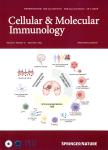Retinoic acid enhances lactoferrin-induced IgA responses by increasing betaglycan expression
Retinoic acid enhances lactoferrin-induced IgA responses by increasing betaglycan expression作者机构:Department of Molecular Bioscience School of Biomedical Science Kangwon National University Chuncheon Republic of Korea Laboratory of Microbiology and Immunology College of Pharmacy Kangwon National University Chuncheon Republic of Korea Department of Systems Immunology College of Biomedical Science Kangwon National University Chuncheon 200-701 Republic of Korea College of Veterinary Medicine Kangwon National University Chuncheon Gangwon 200-701 Republic of Korea Department of Animal Life and Environmental Science College of Agriculture and Life Science Hankyong National University Anseong-si 456-749 Republic of Korea
出 版 物:《Cellular & Molecular Immunology》 (中国免疫学杂志(英文版))
年 卷 期:2016年第13卷第6期
页 面:862-870页
核心收录:
学科分类:10[医学]
基 金:supported by a National Research Foundation of Korea (NRF) grant funded by the Korean government (MEST) the second stage of the Brain Korea 21 program
主 题:gut homing molecule IgA lactoferrin retinoic acid TGF-β receptor
摘 要:Lactoferrin (LF) and retinoic acid (RA) are enriched in colostrum, milk, and mucosal tissues. We recently showed that LF-induced IgA class switching through binding to betaglycan (transforming growth factor-beta receptor III, TpRIII) and activation of canonical TGF-p signaling. We investigated the combined effect of LF and RA on the overall IgA response. An increase in IgA production by LF was further augmented by RA. This combination effect was also evident in Ig germ-line α (GLa) transcription and GLa promoter activity, indicating that LF in cooperation with RA increased IgA isotype switching. We subsequently found that RA enhanced TβRIII expression and that this increase contributed to LF-stimulated IgA production. In addition to the IgA response, LF and RA in combination also enhanced the expression of the gut-homing molecules C-C chemokine receptor 9 (CCR9) and a4β7 on B cells. Finally, peroral administration of LF and RA enhanced the frequency of CCR9+ IgA+ plasma cells in the lamina propria. Taken together, these results suggest that LF in cooperation with RA can contribute to the establishment of gut IgA responses.




